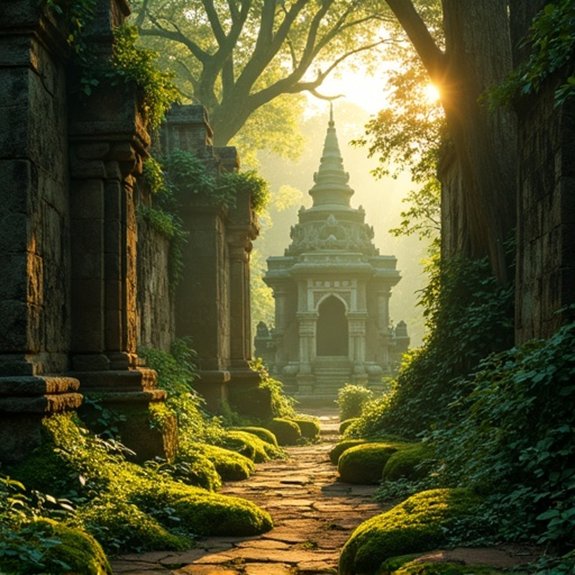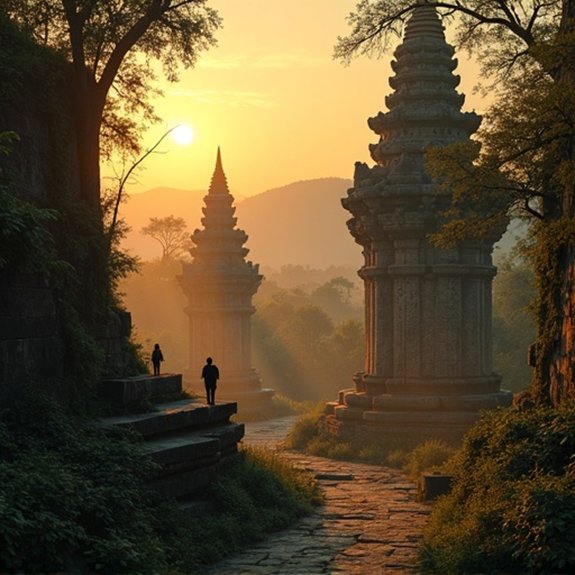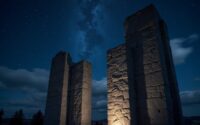The Lost Buddhist City of India
Hidden within Bihar’s dense jungles, the ruins of ancient Nalanda hold secrets that archaeologists are still uncovering. This sprawling Buddhist metropolis once educated over 10,000 students from across Asia before Turkish invaders destroyed it in 1193. For centuries, the site remained lost to history, swallowed by vegetation and time. What drove thousands of scholars to journey here, and what knowledge disappeared when its vast libraries burned?
Introduction

When British colonial officers stumbled upon vine-covered ruins deep in Bihar’s jungles in 1861, they couldn’t have imagined they’d discovered one of Buddhism’s most sacred sites. The ancient city of Nalanda had vanished from memory for nearly seven centuries, buried beneath layers of earth and tropical vegetation. Once Asia’s greatest center of learning, this sprawling monastic university attracted thousands of scholars from China, Korea, Japan, Tibet, and Southeast Asia between the 5th and 12th centuries CE. Its vast libraries housed millions of manuscripts while its teachers shaped Buddhist philosophy for generations. Turkish invaders destroyed Nalanda in 1193, and the jungle quickly reclaimed what remained. The site’s rediscovery would transform understanding of India’s Buddhist heritage and spark archaeological investigations that continue today.
Ancient Nalanda’s Founding Century
The Gupta Empire’s golden age in the 5th century CE provided fertile ground for Nalanda’s establishment as a major Buddhist monastery. Emperor Kumaragupta I founded the institution around 427 CE, transforming a modest Buddhist site into an organized center of learning. The empire’s prosperity enabled substantial royal patronage, funding construction of the first residential halls and lecture spaces.
Buddhist monks initially arrived from across India, drawn by Nalanda’s growing reputation for rigorous philosophical debates. The monastery’s strategic location in Magadha, Buddhism’s heartland, attracted scholars who’d previously studied at older centers like Taxila. By century’s end, Nalanda housed over 500 monks and offered systematic instruction in Buddhist texts, logic, and meditation practices. This foundation period established administrative structures that’d sustain the university for seven centuries.
Notable Cases or Sightings

Although Nalanda’s ruins lay buried for centuries after its destruction, British surveyor Francis Buchanan-Hamilton first documented the site’s significance in 1812 during his survey of Bihar districts. He’d encountered massive brick mounds that locals called “Baragaon” and recorded detailed observations about scattered sculptures and inscriptions.
Alexander Cunningham’s archaeological survey in 1861 marked the site’s formal identification as ancient Nalanda. His team discovered the university’s official seal bearing the inscription “Sri-Nalanda-Maha-Vihara,” confirming centuries-old Chinese pilgrim accounts.
Major excavations began under Hiranand Sastri in 1915, uncovering eleven monasteries and six brick temples. Archaeologists found bronze Buddha statues, terracotta plaques, and thousands of manuscripts. The site’s most striking discovery came in 1920 when excavators unearthed the Great Stupa‘s base, measuring 100 feet wide and containing votive stupas dating to Ashoka’s reign.
Common Theories or Explanations
While scholars generally agree on Nalanda’s historical importance, they’ve proposed competing theories about why the university achieved such extraordinary influence across Asia for nearly seven centuries. Some historians attribute its success to royal patronage from the Gupta and Pala dynasties, which provided stable funding and political protection. Others emphasize its strategic location along ancient trade routes, facilitating cultural exchange between South and East Asia.
Recent archaeological evidence suggests Nalanda’s advanced curriculum attracted students worldwide. The university’s libraries reportedly contained nine million manuscripts, offering extensive education in mathematics, astronomy, medicine, and Buddhist philosophy. Several researchers argue that Nalanda’s residential system, housing over 10,000 students and 2,000 teachers, created an intellectual ecosystem unmatched in the ancient world. This concentration of scholars fostered innovation and preserved knowledge through turbulent periods.
Frequently Asked Questions
How Much Does It Cost to Visit the Archaeological Site Today?
Visitors don’t pay an entry fee to explore the archaeological site since it’s free and open to the public. They’ll only need to cover their transportation costs to reach the remote location in India.
What Are the Nearest Airports and Transportation Options to Reach the Ruins?
Visitors can fly into Bhubaneswar Airport, located 65 kilometers away, or Cuttack’s Charbatia Air Base. They’ll find regular buses, taxis, and private cars available for the journey to Ratnagiri’s ruins, taking approximately two hours.
Are There Guided Tours Available in Languages Other Than English and Hindi?
Yes, guided tours are available in several languages including Japanese, Chinese, French, and German at major Buddhist sites. Tour operators in Bodh Gaya, Sarnath, and Nalanda often provide multilingual guides, though availability varies seasonally.
What Months Offer the Best Weather Conditions for Visiting the Site?
The best months to visit are October through March when temperatures stay cooler and rainfall’s minimal. Winter months particularly offer pleasant conditions for exploring the archaeological ruins, with December and January providing the most comfortable weather overall.
Can Visitors Access All Excavated Areas or Are Some Sections Restricted?
Visitors can’t access all excavated areas at most Buddhist archaeological sites in India. They’ll find certain sections restricted for preservation, ongoing excavations, or safety reasons. Authorities typically mark accessible pathways and viewing areas clearly for tourists.


